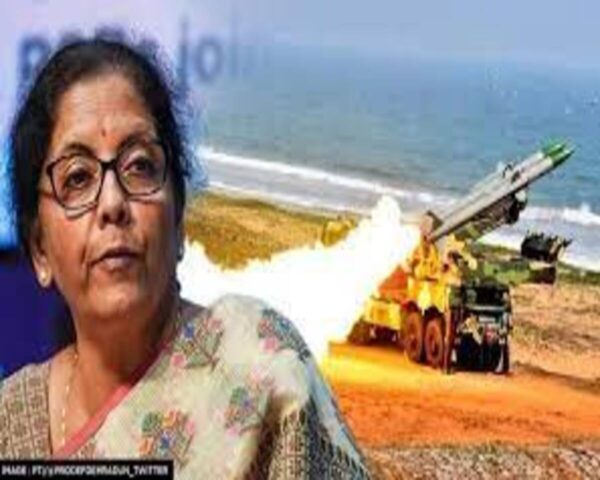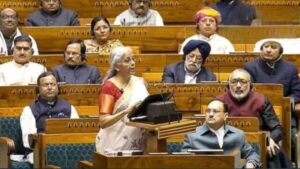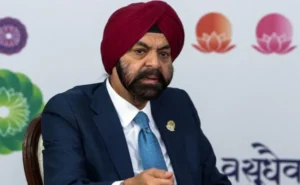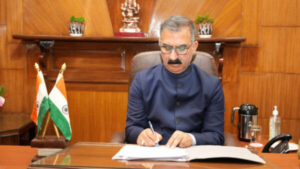India’s biggest weapon: Annual Budget 2023 ?
- The Indian Budget
- Power of the Indian Budget
- What did we learn from the 2022 Budget?
- Expectations from the Annual Budget 2023
- Game Changer for India

India’s biggest weapon: Annual Budget 2023
- The Indian Budget
- The Union budget, which affects the lives of an estimated population of 130 crores, carries with it high expectations and hopes. Each year, it is greeted with great anticipation and credibility as it lays out the government’s plans for the economic and social well-being of the nation. The budget is closely watched by investors, businesses, and citizens as it sets the direction for the country’s economic policies and priorities for the upcoming fiscal year, and provides an overview of the government’s plans for revenue and expenditure. It is a crucial document that has a significant impact on the lives of the citizens and shapes the future of the country.
- The tradition has been that the Finance Minister of India presents the Union Budget to the parliament on February 1st of each year. This has been the practice since 2017. Before this, the budget was presented on the last working day of February. The budget speech is delivered in the Lok Sabha, the lower house of the Indian parliament, and it is a comprehensive document that outlines the government’s financial policies and plans for the upcoming fiscal year. The budget is closely watched by investors, businesses, and citizens as it lays out the government’s plans for revenue and expenditure and provides an overview of the government’s economic policies and priorities for the year ahead.
- The broad objectives of the Union budget as laid out under Article 112 of the Constitution of India are:
- Reallocation of Resources: The budget aims to reallocate resources to ensure that they are used most efficiently and effectively to achieve the government’s policy objectives.
- Reducing Inequality: The budget aims to reduce income and wealth inequality by redistributing resources to support the most vulnerable segments of society.
- Controlling Prices: The budget aims to control prices and inflation through monetary and fiscal policies.
- Resource Management: The budget aims to manage resources effectively to ensure sustainable economic growth and development.
Overall, the Union budget serves as a tool for the government to implement its economic policies and achieve its overall development goals.
- The preparation of the Union budget is a year-long process, which mainly involves four stages:
- Formulation: Administrative Ministers share their budget estimates with the Finance Ministry and after meetings and analysis, a tentative budget is approved.
- Enactment: The budget is presented in the parliament, and discussions on the budget are done in both houses of the parliament. After which the appropriate bill is passed in the parliament by March.
- Implementation: Once the general budget is passed, the executives carry out the various implementation processes of expenditure and revenue processes.
- Audit: The auditing of various expenditure and revenue receipts is carried out by the office of the Auditors General, and later this report is presented in the parliament.
- Overall, the union budget is a complex process that involves extensive collaboration between different government departments, agencies, and the parliament. It is an important document that lays out the financial priorities of the government and provides an overview of the government’s revenue and expenditure projections, including expected revenue from taxes and other sources, and details of planned government spending on various programs and initiatives.
- Power of the Indian Budget
- Each year, the Union budget presented by the Government of India serves as a blueprint for the management of the government’s expenditures and revenue (receipts) for the upcoming fiscal year. It lays out the financial priorities of the government and provides an overview of the government’s revenue and expenditure projections, including expected revenue from taxes and other sources, and details of planned government spending on various programs and initiatives. The budget also highlights the government’s economic policies and provides insight into the government’s overall fiscal strategy. The Union budget is an important document that provides a comprehensive view of the government’s financial position and its plans for the future.
- Given the recent onset of a global recession and the ongoing recovery of global economies from the post-pandemic situation, it is of paramount importance for the government to ensure that the Indian economy remains stable and efficient in the long term.
- What did we learn from the 2022 Budget?
- The 2022 budget by the Government of India prioritized growth and inclusive welfare, emphasized technology-enabled development, energy transition and climate action, and aimed to trigger a virtuous cycle of private investment crowding in public capital investment.
- The major priorities of the Government during the budget of Amrit-Kaal were:
- Post-pandemic recovery and sustainable growth
- Prioritizing the Ministry of Defence, Ministry of Consumer Affairs, Food and Public Distribution and the Ministry of Road and Transportation Affairs
- Tax reliefs for the disabled
- Imposition of additional differential excise duty on unblended fuel to reduce dependence on fuel
- Providing disposable income to citizens
- Injecting liquidity into the economy
- Avoiding undue burden on specific segments of society
- Shaping the future of India in 2030
- Addressing the potential threat of global events such as the energy crisis, interest rate hikes, and the possibility of a recession.
- The primary focus of the 2022 budget was on post-pandemic recovery and sustainable growth, which reflects the government’s commitment to addressing the immediate challenges posed by the pandemic while also building a strong and resilient economy for the future.
- The Ministry of Defence was given top priority in the budget, which experts believe is a response to the escalating tensions on the border with China. Additionally, the Ministry of Consumer Affairs, Food and Public Distribution and the Ministry of Road and Transportation Affairs were also prioritized in the budget, indicating the government’s focus on these key areas like food security for the citizens and improvising road infrastructure.
- The budget also included tax reliefs for the disabled, in line with the government’s efforts to support the most vulnerable sections of society. Additionally, the imposition of additional differential excise duty on unblended fuel was highlighted as a measure to support the government’s goal of reducing dependence on fuel.
- Overall, it is evident that the government aimed to increase its expenditure to drive overall economic growth and has been successful to some extent. India has surpassed the United Kingdom to become the world’s 5th largest economy with an overall GDP growth rate of 7% in 2022, reaching a GDP of 3.1 Trillion USD.
- Expectations from the Annual Budget 2023
- In a press conference, the Finance Minister, Mrs Nirmala Sitharaman, stated that the Prime Minister had given clear instructions to not impose undue burdens on taxpayers and the middle-income group in the post-pandemic era. As the 2023 Budget approaches, the middle-class group anticipates the inclusion of tax slab reductions, which have been absent in recent budgets.
- It is reported that there are plans to implement a significant 30% reduction in the tax slabs for the middle-income groups and salaried class. Furthermore, there is speculation that the tax exemption limit may be revised to 5 lakhs, an increase from the previous limit of 2.5 lakhs.
- The recent hike in the repo rate by 35 basis points to 6.25% has had a domino effect on the economy, leading to an increase in interest rates for home loans, EMIs, and even GST slabs for essential commodities. This has resulted in a decline in savings for the middle class.
- Analysis suggests that the government will focus on injecting more liquidity into the economy, as citizens have seen their savings decline and cash flow decrease over the past two years.
- Given these factors, an increase in disposable income for citizens will lead to a rise in overall production levels.
- Game changer for India
- Since the beginning of 2022, there have been significant changes in the geopolitical landscape around the world, from the ongoing conflict in Ukraine to tensions between China and Taiwan, and these developments are beginning to have a noticeable impact on global economies.
- Reports of a potential worldwide recession have been circulating in the news and countries such as Europe and the United States have been the most affected. In light of this, India must adopt a balanced approach when considering injecting liquidity into its economy, taking into account the current geopolitical and economic conditions of the world.
- Our neighbouring countries such as Sri Lanka, Bangladesh, Pakistan and even China have begun to experience the impacts of slowing global economies and the possibility of a recession.
- The recent interest rate hikes by the Federal Reserve of the United States have had a widespread effect on markets around the world, including a significant impact on the currency carry trade. While the effects may not be immediately apparent, they are likely to have a long-term impact on Indian markets.
- The global energy crisis has affected various regions of the world; however, India has managed to avoid its impacts due to the effective diplomatic efforts that have enabled the substitution of energy needs from other sources, thus helping the Indian economy remain relatively insulated from this global crisis. Given the volatility of the Indian market, it is crucial to take into account the potential threat of the global energy crisis in the formulation of the annual Budget for 2023.
- Therefore, the new India budget is not only crafted with the present in mind but also with an eye on shaping the future of India in 2030. This means that the government must take into account the current geopolitical and economic conditions of the world, as well as the potential threats and opportunities that may arise in the future. It is crucial to consider the potential impact of global events such as the energy crisis, interest rate hikes and the possibility of a recession. With this in mind, the budget should aim to provide long-term solutions that will not only address current issues but also build a resilient and sustainable economy for the future. Additionally, the government must ensure that the budget is inclusive and does not impose undue burdens on specific segments of society, particularly the middle-class and salaried citizens.
Frequently Asked Questions
(Annual Budget 2023)
- When is the Union Budget presented in India?
- The Union Budget is presented by the Finance Minister on the first day of February each year.
- What is the purpose of the Union Budget?
- The Union Budget is a comprehensive document that outlines the government’s financial policies and plans for the upcoming fiscal year. It provides an overview of the government’s revenue and expenditure projections and details of planned government spending on various programs and initiatives
- Who prepares the Union Budget?
- The Union Budget is prepared by the Ministry of Finance and presented by the Finance Minister in the parliament.
- What are the main components of the Union Budget?
- The main components of the Union Budget include the revenue budget and the capital budget. The revenue budget includes estimates of revenue from taxes and other sources, and the capital budget includes details of planned government spending on various programs and initiatives.
- How does the Union Budget affect the economy?
- The Union Budget has a significant impact on the economy as it sets the direction for the country’s economic policies and priorities for the upcoming fiscal year. It also affects the allocation of resources and the government’s plans for social welfare programs
- How can citizens access the Union Budget?
- The Union Budget is available on the official website of the Ministry of Finance, and it is also widely covered by media outlets.
- What are the main expectations of the Union budget?
- The main expectations of the Union budget are usually on the government’s plans for revenue and expenditure, tax reliefs, job creation, infrastructure development, agriculture and rural development, healthcare and education, and measures to control inflation and boost economic growth.

Continuing the achievement of the journey of effectiveness and credibility of more than 10 years in the career of journalism, as a woman journalist, I am Serving as the founder, promoter and editor of DiaryTimes with the trust and support of all. My credible coverage may not have given a big shape to the numbers, but my journey presents articles that make you aware of the exact and meaningful situations of Himachal’s politics, ground issues related to the public, business, tourism and the difficult geographical conditions of the state and financial awareness. DiaryTimes, full of the experience of my precise editorial expertise, is awakening the flame of credible journalism among all of you, so that the eternal flame of meaningful change can be lit in the life of the people of the state and the atrocities being committed against the people can be brought to the fore, I am motivated for that. If even a small change comes with the power of my journalism and the whole world becomes a witness to that issues, then I will consider myself fortunate.








